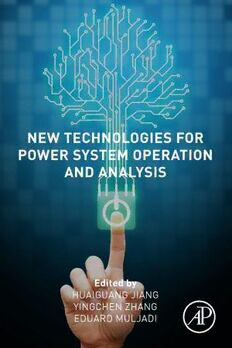Table Of ContentN T
EW ECHNOLOGIES FOR
P S O
OWER YSTEM PERATION
A
AND NALYSIS
N T
EW ECHNOLOGIES FOR
P S O
OWER YSTEM PERATION
A
AND NALYSIS
Edited by
HUAIGUANG JIANG
National Renewable Energy Laboratory, Golden, CO,
United States
YINGCHEN ZHANG
Chief Engineer and Group Manager of National
Renewable Energy Laboratory, Golden, CO, United States
EDUARD MULJADI
Department of Electrical and Computer Engineering,
Auburn University, Auburn, AL 36849, United States
AcademicPressisanimprintofElsevier
125LondonWall,LondonEC2Y5AS,UnitedKingdom
525BStreet,Suite1650,SanDiego,CA92101,UnitedStates
50HampshireStreet,5thFloor,Cambridge,MA02139,UnitedStates
TheBoulevard,LangfordLane,Kidlington,OxfordOX51GB,UnitedKingdom
Copyright©2021ElsevierInc.Allrightsreserved.
Nopartofthispublicationmaybereproducedortransmittedinanyformorbyanymeans,
electronicormechanical,includingphotocopying,recording,oranyinformationstorageand
retrievalsystem,withoutpermissioninwritingfromthepublisher.Detailsonhowtoseek
permission,furtherinformationaboutthePublisher’spermissionspoliciesandourarrangements
withorganizationssuchastheCopyrightClearanceCenterandtheCopyrightLicensingAgency,
canbefoundatourwebsite:www.elsevier.com/permissions.
Thisbookandtheindividualcontributionscontainedinitareprotectedundercopyrightbythe
Publisher(otherthanasmaybenotedherein).
Notices
Knowledgeandbestpracticeinthisfieldareconstantlychanging.Asnewresearchandexperience
broadenourunderstanding,changesinresearchmethods,professionalpractices,ormedical
treatmentmaybecomenecessary.
Practitionersandresearchersmustalwaysrelyontheirownexperienceandknowledgein
evaluatingandusinganyinformation,methods,compounds,orexperimentsdescribedherein.In
usingsuchinformationormethodstheyshouldbemindfuloftheirownsafetyandthesafetyof
others,includingpartiesforwhomtheyhaveaprofessionalresponsibility.
Tothefullestextentofthelaw,neitherthePublishernortheauthors,contributors,oreditors,
assumeanyliabilityforanyinjuryand/ordamagetopersonsorpropertyasamatterofproducts
liability,negligenceorotherwise,orfromanyuseoroperationofanymethods,products,
instructions,orideascontainedinthematerialherein.
BritishLibraryCataloguing-in-PublicationData
AcataloguerecordforthisbookisavailablefromtheBritishLibrary
LibraryofCongressCataloging-in-PublicationData
AcatalogrecordforthisbookisavailablefromtheLibraryofCongress
ISBN:978-0-12-820168-8
ForInformationonallAcademicPresspublications
visitourwebsiteathttps://www.elsevier.com/books-and-journals
Publisher:JoeHayton
AcquisitionEditor:LisaReading
EditorialProjectManager:AliAfzalKhan
ProductionProjectManager:R.VijayBharath
CoverDesigner:GregHarris
TypesetbyMPSLimited,Chennai,India
Contents
Listofcontributors ix
1. Introduction 1
YanLi,ChanghongZhao,HuaiguangJiang,YingchenZhangand
EduardMuljadi
1.1 Overviewofpowersystems 1
1.2 ThedevelopmenthistoryofpowersystemsintheUnitedStates 4
1.3 Distributedenergyresourceunits 5
1.4 Steady-stateconditions 8
1.5 AIandmachinelearning 10
1.6 Networkdynamicoperation 11
1.7 Multisectorcoupling 15
1.8 Structureofthisbook 17
References 17
2. Decoupled linear AC power flow models with accurateestimation
ofvoltage magnitudein transmission and distribution systems 23
NingZhang,JingweiYang,YiWang,HaiLiandChongqingKang
Nomenclature 23
2.1 Introduction 24
2.2 Linearpowerflowmodelsforthemeshedtransmissionsystems 26
2.3 Linearthree-phasepowerflowmodelsoftheunbalanceddistribution
systems 37
2.4 Casestudy 40
2.5 Conclusion 47
References 47
3. Renewable energy integration and system operationchallenge:
controland optimization of millions ofdevices 49
YingXu,WeiSunandZhihuaQu
3.1 Introduction 50
3.2 Distributionsystemmodelwithhighpenetrationofrenewables 52
3.3 Autonomousdistributedvoltagecontrol 57
3.4 Hierarchicalmultiagentcontroloflarge-scaledistributionsystem 68
v
vi Contents
3.5 Islandedmicrogridwithhighpenetrationofdistributedgenerations 74
3.6 Grid-edgesituationalawareness:enhancedobservabilitybyvoltage
inference 79
3.7 Control-enableddynamichostingallowance:PandQcontrolcapacityand
impactanalysis 86
3.8 Cosimulationofintegratedtransmissionanddistributionsystems 91
3.9 Conclusion 95
References 97
4. Advances ofwholesale andretail electricitymarket development
in the context ofdistributed energy resources 99
QinWang
4.1 Introduction 99
4.2 Modernwholesaleelectricitymarket 100
4.3 Modernretailelectricitymarket 130
4.4 Conclusion 140
References 140
5. Wide-area monitoring and anomalyanalysis based on
synchrophasor measurement 143
ShutangYou,YuSu,YongLiuandYiluLiu
5.1 Synchrophasormeasurementtechnologyintroduction 144
5.2 Wide-areameasurementsystemexample—FNET/GridEye 147
5.3 FNET/GridEyewide-areameasurementsystemapplicationsoverview 151
References 160
Furtherreading 161
6. Advanced grid operationaltools based onstateestimation 163
YuLiu,YuzhangLinandJunboZhao
6.1 Introduction 163
6.2 Modelvalidation 165
6.3 Systemmonitoring 178
6.4 Protectiverelaying 192
6.5 Conclusionremarks 204
References 205
Furtherreading 208
Contents vii
7. Advanced machine learning applications to modern power
systems 209
CongFeng,MucunSun,MortezaDabbaghjamanesh,YuanzhiLiuandJieZhang
7.1 Introduction 209
7.2 Modernforecastingtechnology 212
7.3 Machinelearning(cid:1)basedcontrolandoptimization 228
7.4 Advancedartificialintelligenceandmachinelearningapplicationsto
buildingoccupancydetection 235
7.5 Conclusion 251
References 252
8. Power system operation with power electronic
inverter(cid:1)dominated microgrids 259
YuhuaDu,XiaonanLuandXiongfeiWang
Nomenclature 259
8.1 Powersystemevolutiontowardmodernization 260
8.2 Networkedmicrogridswithparallelinverters 261
8.3 Parallelinverteroperationinmicrogrids 264
8.4 Conclusion 273
References 274
9. Automated optimalcontrol in energy systems:
the reinforcement learning approach 275
XiangyuZhangandHuaiguangJiang
9.1 Introduction 276
9.2 Deepreinforcementlearning 286
9.3 Reinforcementlearninginenergysystems 297
References 314
10.Power, buildings, andothercritical networks: Integrated
multisystem operation 319
KyriBaker
10.1 Introduction 320
10.2 Grid-interactivebuildings 327
10.3 Interdependentcriticalnetworks 338
10.4 Electrificationofthetransportationsector 347
10.5 Considerationsforfuturepowersystems 352
Acknowledgments 354
References 354
Index 359
List of contributors
KyriBaker
UniversityofColoradoBoulder,Boulder,CO,UnitedStates
MortezaDabbaghjamanesh
DepartmentofMechanicalEngineering,TheUniversityofTexasatDallas,Richardson,
TX,UnitedStates
YuhuaDu
TempleUniversityCollegeofEngineering,Philadelphia,PA,UnitedStates
CongFeng
DepartmentofMechanicalEngineering,TheUniversityofTexasatDallas,Richardson,
TX,UnitedStates
HuaiguangJiang
NationalRenewableEnergyLaboratory,Golden,CO,UnitedStates
ChongqingKang
DepartmentofElectricalEngineering,TsinghuaUniversity,Beijing,P.R.China
HaiLi
DepartmentofElectricalEngineering,TsinghuaUniversity,Beijing,P.R.China
YanLi
PennsylvaniaStateUniversity,UniversityPark,StateCollege,PA,UnitedStates
YuzhangLin
DepartmentofElectricalandComputerEngineering,UniversityofMassachusetts,Lowell,
MA,UnitedStates
YiluLiu
UniversityofTennessee,Knoxville,TN,UnitedStates;OakRidgeNationalLaboratory,
OakRidge,TN,UnitedStates
YongLiu
PacificGasandElectricCompany,SanFrancisco,CA,UnitedStates
YuLiu
SchoolofInformationScienceandTechnology,ShanghaiTechUniversity,Shanghai,P.R.
China
YuanzhiLiu
DepartmentofMechanicalEngineering,TheUniversityofTexasatDallas,Richardson,
TX,UnitedStates
XiaonanLu
TempleUniversityCollegeofEngineering,Philadelphia,PA,UnitedStates
EduardMuljadi
AuburnUniversity,Auburn,AL,United,States
ix
x Listofcontributors
ZhihuaQu
DepartmentofElectricalandComputerEngineering,UniversityofCentralFlorida,FL,
UnitedStates
YuSu
UniversityofTennessee,Knoxville,TN,UnitedStates
MucunSun
DepartmentofMechanicalEngineering,TheUniversityofTexasatDallas,Richardson,
TX,UnitedStates
WeiSun
DepartmentofElectricalandComputerEngineering,UniversityofCentralFlorida,FL,
UnitedStates
QinWang
DepartmentofPowerDelivery&Utilization,ElectricPowerResearchInstitute,Palo
Alto,CA,UnitedStates
XiongfeiWang
DepartmentofEnergyTechnology,AalborgUniversity,Aalborg,Denmark
YiWang
DepartmentofElectricalEngineering,TsinghuaUniversity,Beijing,P.R.China
YingXu
DepartmentofElectricalandComputerEngineering,UniversityofCentralFlorida,FL,
UnitedStates
JingweiYang
DepartmentofElectricalEngineering,TsinghuaUniversity,Beijing,P.R.China
ShutangYou
UniversityofTennessee,Knoxville,TN,UnitedStates
JieZhang
DepartmentofMechanicalEngineering,TheUniversityofTexasatDallas,Richardson,
TX,UnitedStates
NingZhang
DepartmentofElectricalEngineering,TsinghuaUniversity,Beijing,P.R.China
XiangyuZhang
NationalRenewableEnergyLaboratory,Golden,CO,UnitedStates
YingchenZhang
NationalRenewableEnergyLaboratory,Golden,CO,UnitedStates
ChanghongZhao
ChineseUniversityofHongKong,HongKong,P.R.China
JunboZhao
DepartmentofElectricalandComputerEngineering,MississippiStateUniversity,
Starkville,MS,UnitedStates
CHAPTERONE
Introduction
Yan Li1, Changhong Zhao2, Huaiguang Jiang3, Yingchen Zhang3
and Eduard Muljadi4
1PennsylvaniaStateUniversity,UniversityPark,StateCollege,PA,UnitedStates
2ChineseUniversityofHongKong,HongKong,P.R.China
3NationalRenewableEnergyLaboratory,Golden,CO,UnitedStates
4AuburnUniversity,Auburn,AL,United,States
Contents
1.1 Overviewofpowersystems 1
1.2 ThedevelopmenthistoryofpowersystemsintheUnitedStates 4
1.3 Distributedenergyresourceunits 5
1.4 Steady-stateconditions 8
1.5 AIandmachinelearning 10
1.6 Networkdynamicoperation 11
1.7 Multisectorcoupling 15
1.8 Structureofthisbook 17
References 17
1.1 Overview of power systems
The modern power grid is one of the most complex human-made
engineering systems. In power grids, there are three subsystems, that is,
generation system, transmission system, and distribution system, as shown
in Fig. 1.1. In the generation system, electricity is produced in power
plants through burning fossil fuels (e.g., coal, gas, and oil), nuclear mate-
rial, or using hydroelectric power plants. The function of generation sys-
tems is to convert chemical energy to electric energy. Then the electrical
energy is converted to a higher voltage level through transformers and
transmitted through the power lines in the transmission system. Once the
energy has traveled through the transmission system, the voltage is
brought back down. Then, the energy reaches the distribution system,
where we deliver energy to residential customers, commercial customers,
industry, and other power loads.
NewTechnologiesforPowerSystemOperationandAnalysis. ©2021ElsevierInc.
DOI:https://doi.org/10.1016/B978-0-12-820168-8.00001-8 Allrightsreserved. 1
2 YanLietal.
Figure1.1 Overviewofpowersystems.
Power generation in the traditional power grid is highly centralized,
with power and energy flowing unidirectionally from generators in the
generation system through a transmission/distribution network to end
users. However, technological issues of traditional electric utilities as well
as environmental problems caused by the combustion of fossil fuels have
prompted the research and development of new pattern of power systems.
With the emergence of distributed energy resource (DER) units (cid:1)for
example, wind, photovoltaic (PV), battery, biomass, micro-turbine, and
fuel cell (cid:1) microgrids have attracted increasing attention as an effective
means of integrating such DER units into power systems.
The major constituents in microgrid are [1] DER units for power gen-
eration and energy storage, control systems for power/energy control and
dispatch, and controllable loads for demand response. Microgrid research
and development is currently propelled by technology advances in renew-
able energy, power electronics (PEs), control theory, data management,
interconnected systems, wireless networks, as well as advances in interop-
erability and high-performance computing. The abovementioned tech-
nologies have been increasing the complexity of operation and control
of microgrids. On one hand, microgrids will create a complicated

